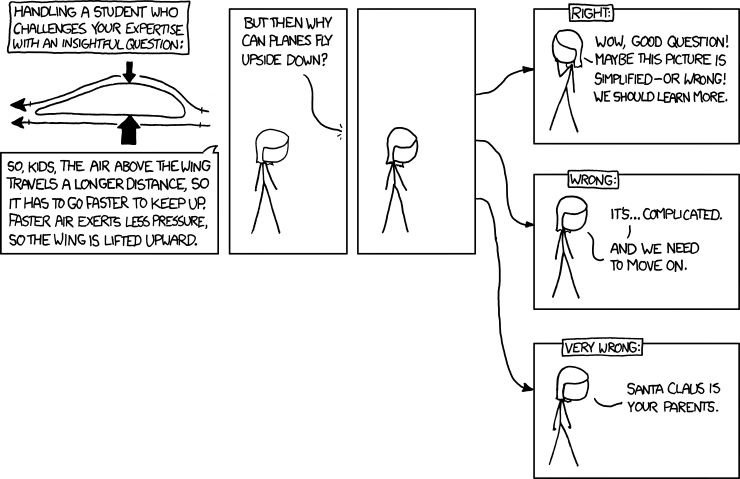
scream-of-consciousness; "If you're trying to change minds and influence people it's probably not a good idea to say that virtually all elected Democrats are liars, but what the hell."
Friday, October 15, 2010
Woman who fly plane upside down bound to have crack up - Charlie Chan

"If the number of Islamic terror attacks continues at the current rate, candlelight vigils will soon be the number-one cause of global warming. " |
| This will be the comment box |
9 comments:
-
Anonymous said...

-
Correct Answer: We used to thing wings were hot air balloons.....turns out they are really surf boards.
-
10/15/10, 9:24 AM

-
DaveInFla said...

-
Easy answer, the ELEVATOR.
-
10/15/10, 9:54 AM

-
Anonymous said...

-
With todays students, for the most part, the question would never be asked. In most classrooms, the teacher wouldn't be able to answer.
Ok, if it is: 'pressure is lower on the upper surface of the wing', then please be 'splainin' to me howcum there is a lot of downwash from helicopter blades? Should just be a lot of "lower pressure" pullin' them blades up towards the heavens... Shouldn't there???
If props are just 'wings' turned on their side, why is there prop wash? Should just be pressure on the leading surface of the wing.
No one has ever explained this to me. Someone must know.
tomw -
10/15/10, 12:17 PM

- Kristophr said...
-
It's because the Bernoulli effect is only a small portion of the lift a plane generates.
Most of it is generated by the plane's wing's angle of attack plus engine thrust.
Angle of attack vs torque ( angular thrust ) is also why a spinning prop, or a helicopter blade, generates thrust at right angles to rotation.
When a plane flies upside down, the pilot adjusts the plane's angle of attack with the stick until the airplane stops losing altitude.
The Bernoulli effect was the main source of lift back at the dawn of flight, when power to weight ratios were just barely beyond the fly like a brick stage. As usual, public school science texts and teachers are behind the curve by about a hundred years. -
10/15/10, 12:58 PM

-
Alear said...

-
Or bring in guest lecturer Ian Fortune. Watch the video, very compelling. And again the Brits with their understatement, come up with the quote of the day: "I've got a bit of a crack and a bleed there."
-
10/15/10, 1:00 PM

-
Anonymous said...

-
Kristopher is correct. Most planes don't fly very well upside down. The ones that do - that you see doing aerobatics at airshows - have a more symmetrical profile than you see pictured above. They're more like an elongated teardrop so that they work as well upside down and generate lift by adjusting the elevators and angle of attack and using an over powered engine.
GrinfilledCelt -
10/15/10, 3:08 PM

-
Anonymous said...

-
In wind tunnel simulations using only the Bernouli effect, a Cessena 152 must obtain a speed of 242 MPH to lift off the ground. Bernouli was just a side effect of lift.
-
10/15/10, 9:00 PM

-
Anonymous said...

-
Thank you alear, fantastic link
MM -
10/15/10, 10:15 PM

- DougM said...
-
The cartoon is brilliant in pointing out that when a teacher tries to explain a complex phenomenon that was over-simplified at that textbook level, the first good question may require a wider understanding of all sorts of other science, math, or technologies.
Kristopher & GC are correct. The diagram here is a special case, zero angle of attack (alpha). Because the airfoil shown is asymmetrical, there will be some lift at zero alpha, but not much at low speed (lift is a function of speed, angle of attack for a particular airfoil shape, air density ...). But that's not what designers shoot for. General cruising flight uses a compromise airfoil shape over a range of alphas, stall speed (slow landing speed) at high alpha, cruising speed (low drag for fuel efficiency) at low alpha, but not zero, so the wing is fixed at this cruising-alpha angle with respect to the level-flight centerline of the fuselage.
Inverted, most airfoils will develop lift at much higher angles of attack (negative alpha) with much higher drag and control instabilities. You know, they fly lousy.
Aerobatic airfoil shapes are designed for inversion, but they sacrifice low-speed landing, cruising efficiency, and stability. They can fly inverted tolerably well, but not efficiently, and not without high skill.
tomw,
Think "fan." The lower-pressure side sucks air from the surroundings, and the higher-pressure side air rushes away into the lower pressure area. That pressure differential is generated across the prop/rotor surface by motion through the air just like a wing (air at near-zero kinetic energy is converted by power and airfoil shape & motion into high kinetic energy in a helpful direction). The whole point is to generate the needed thrust by moving as much air as fast and as efficiently as possible wrt fuel consumption. Airplane & helo propulsion systems (incl. jets) are just air pumps. [next week: rockets]
Consider the surface scratched. -
10/15/10, 10:23 PM
